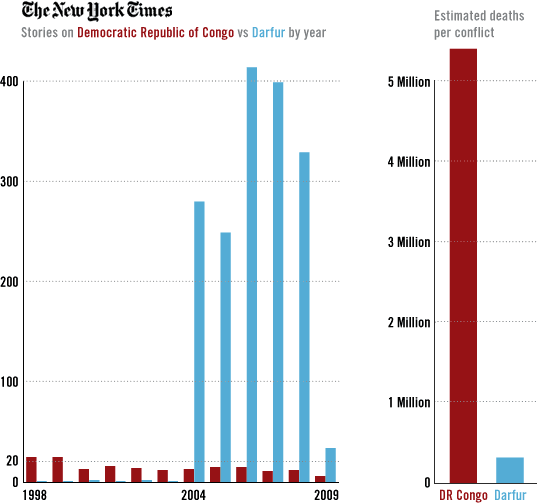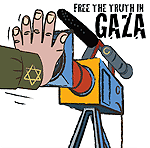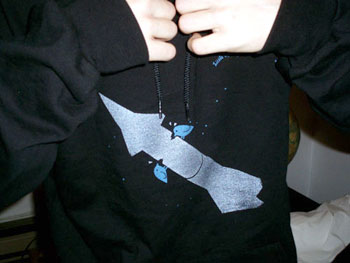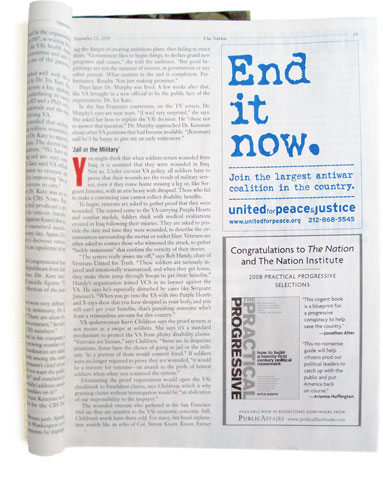war
The Invisible War
On February 21, 2009 Bob Herbert published a column in the New York Times calling the war in the Democratic Republic of Congo “The Invisible War.” After a decade of bloodshed, millions killed and displaced, and an active UN peacekeeping force, why is Africa’s World War so invisible? He actually doesn’t speculate.
Perhaps Mr. Herbert should inquire at the editorial desk. Using the NY Times Article Search API I ran a query by year on the term “Democratic Republic of Congo.” The Times averaged 13.5 stories per year on DR Congo from 1998 through 2008. On the face of it, one story per month seems a nice steady focus. But by comparison, the Times published an average 151.6 stories on Darfur per year during the same period — even though the war in Darfur only started in 2003. In January 2008, the International Rescue Committee published a study reporting the war in DR Congo had claimed 5.4 million lives. In March 2008, the UN estimated the number of deaths in Darfur at 300,000.
Here are the counts of New York Times articles by year, as of February 24, 2009:
| 1998 | 1999 | 2000 | 2001 | 2002 | 2003 | 2004 | 2005 | 2006 | 2007 | 2008 | 2009 | |
| On DR Congo | 24 | 24 | 12 | 15 | 13 | 11 | 12 | 14 | 14 | 10 | 11 | 5 |
| On Darfur | 0 | 0 | 1 | 0 | 1 | 0 | 279 | 248 | 413 | 398 | 328 | 33 |
And a graphic I designed to illustrate it:

For those inclined, here’s the perl script I used to query the API. It borrows heavily from this example.
I realize one should be wary of comparing casualty data gathered with different methodologies, and that the conflict in DR Congo has a five year lead. But a million here, a million there, the disparity is still dramatic.
So why does Darfur get so much more coverage than DR Congo? Do the Arab Muslim bad guys in Sudan make a more convenient target for Western Islamophobes? Are China’s competing industrial interests in Sudan easier to finger than US corporate interests in DR Congo? Are the deserts of Darfur simply more accessible than the forests of Northeastern Congo? Or is Darfur a simpler story with clearer victims and perpetrators? A story closer to Western ideas of genocide than Congo’s messier regional war? Certainly the celebrity and NGO pressure on Darfur has helped. I should note that I’m emphatically not arguing that Darfur should be covered less, but that the war in DR Congo should be covered more. Much more.
Update 2/26/2009 — Anneke Van Woudenberg, Senior Researcher at Human Rights Watch sends this response:
“This comparison is both interesting and disturbing. In my ten years of working on Congo I have often wondered why it gets so much less press attention. The difficulties for journalists to get around and the expense of such trips contribute to the problem, but such problems also occur in Darfur or other conflicts that receive more press coverage. The complexities of the Congo conflict - the alphabet soup of armed groups and the constant changing alliances - make it a challenging story to cover. But it is not impossible. So what is it?
I fear that the Congo conflict receives less coverage because many outsiders have bought into the preconception that Congo is the ‘heart of darkness’ as characterized by Joseph Conrad's book by the same title. The book has often been used to refer to Congo’s plight today, as if the country is somehow predisposed to dark atrocities and violence, and hence there is nothing new to report. Yet many have misunderstood the real message of Conrad's book. It is not Congolese barbarism but rather the greed of outsiders that have plagued this country's history. As the narrator of Conrad's book describes, he found in Congo, ‘the vilest scramble for loot that ever disfigured the history of human conscience.’ A situation little changed today. Surely that story is worthy of further press coverage.”
Update 4/16/2009 — Julie Hollar at FAIR points out that The New York Times style does not always refer to DR Congo as “Democratic Republic of Congo,” rather sometimes just “Congo,” which makes the free text search problematic. Instead, I ran an API search for articles by geo tag, comparing documents tagged CONGO (FORMERLY ZAIRE) with documents tagged DARFUR (SUDAN).

By geo tag, Darfur still shows roughly double the coverage of DR Congo. Not quite as dramatic as my first graph, but still disproportionate. Of course this method depends on the Times for accurate tagging of their own articles. It’s unclear why a free text search for “Darfur” turns up so many more results than the geo tag search.
When Design Stopped the War
“But does it work?”
It’s one of those frequently asked questions one often hears at discussions of design and activism. That and the whole preaching to the converted thing. It refers to design specifically, but also protest generally.
It sometimes takes a long time to stop a war, but now and then the impact is immediate. Like the time in February 1998 when protestors disrupted an internationally broadcast “Town Meeting” on Iraq at Ohio State University. Students dropped a NO WAR banner in front of an CNN’s rolling cameras and made such a ruckus that the moderator had to allow them a turn at the mic. Their pointed questions about the war embarrassed the Clinton Administration, tipped public and international support, and prevented an invasion of Iraq. “Not even Ohio supports the bombing, Egyptian President Hosni Mubarak said a few days later. Why should Egypt?”
Of course, it wasn’t this one protest alone, nor solely the banner smuggled into the event. But the action, broadcast around the world via cable news, sealed the deal. Katha Pollit’s March 1998 article tells the story.
Update 3/16/2010: Here’s a transcript of the town hall meeting.
 “Protests were held in Britain, France, Germany, Greece, Ireland, Italy, the Netherlands, Spain and Turkey as the Israeli offensive entered its second week...In many cities people waved shoes — recalling the action of an Iraqi journalist who hurled footwear at U.S. President George W. Bush in Baghdad last month in a symbolic insult. British demonstrators threw dozens of shoes into the street as they passed the gated entrance to Downing Street, where Prime Minister Gordon Brown lives, and shouted angrily at a line of 40 police officers on guard there. ‘Come to get your shoes Gordon,’ one woman shouted as other marchers directed chants of ‘Shame on you’ at Brown.”
“Protests were held in Britain, France, Germany, Greece, Ireland, Italy, the Netherlands, Spain and Turkey as the Israeli offensive entered its second week...In many cities people waved shoes — recalling the action of an Iraqi journalist who hurled footwear at U.S. President George W. Bush in Baghdad last month in a symbolic insult. British demonstrators threw dozens of shoes into the street as they passed the gated entrance to Downing Street, where Prime Minister Gordon Brown lives, and shouted angrily at a line of 40 police officers on guard there. ‘Come to get your shoes Gordon,’ one woman shouted as other marchers directed chants of ‘Shame on you’ at Brown.” “Mr Dromi [a former government press adviser and air force colonel] admitted that the administration will struggle to win hearts and minds if footage of those suffering in Gaza continues to be shown. ‘When you have a Palestinian kid facing an Israeli tank, how do you explain that the tank is actually David and the kid is Goliath? That is why the television kills us.’” Not only has the Israeli government barred journalists from entering Gaza, they also bombed the local TV station on second day of the assault.
“Mr Dromi [a former government press adviser and air force colonel] admitted that the administration will struggle to win hearts and minds if footage of those suffering in Gaza continues to be shown. ‘When you have a Palestinian kid facing an Israeli tank, how do you explain that the tank is actually David and the kid is Goliath? That is why the television kills us.’” Not only has the Israeli government barred journalists from entering Gaza, they also bombed the local TV station on second day of the assault.Meanwhile, the Israeli Consulate in New York yesterday held a “citizen’s press conference” on its new Twitter channel and blog, while the IDF’s new YouTube channel is going strong.
Update January 13, 2009: Hamas has launched its own YouTube equivalent and Al Jazeera has made its latest video from Gaza freely available at broadcast quality under a Creative Commons license.

8 Years Later
This has been blogged pretty heavily, but a friend hadn’t seen it so I’m posting it here. This is my favorite video short of this election cycle. It shows so much in just two minutes: war, Katrina, the economy, housing and infrastructure collapse... telegraphing familiar characters from their past comfort into the present crises, riding humor into pathos and back again into hope. For readers outside the US, the video is based on a short film that became a popular, widely aired TV ad some 8 years ago. More at wikipedia.
Linkbox
A few collections of wonderful things:
- Political street art mostly related to the U.S. presidential election
- Anti-war stencils, a Flickr group
- Activist images and posters from around the world in the traveling Propaganda III exhibition
Little by Little
Opland
It’s among the most recognizable images in Holland. The poster below was drawn by Opland, the pseudonym of Rob Wout, one of Holland’s most popular political cartoonists in the second-half of the twentieth century. For 53 years, from age 19 until his death in 2001, Opland drew caricatures and political cartoons for De Volkskrant and De Groene Amsterdammer. In 1981, at a high point in his career, Opland contributed this cartoon to the anti-nuclear movement. The slogan reads ‘No new nuclear weapons in Europe.’ It became one of his most famous images in the peace movement outside the Netherlands, as well. The image is a nice mix of humor and outrage, clarity and simplicity, with a dash of familiarity. How could you say no to her?

The anti-nuclear movement in Holland had been active through the late-1970’s and in 1978 an unexpected coalition of Communists, leftists, and religious groups organized nation-wide protests and petitions that successfully pressured the center-right government to disallow U.S. neutron warheads in the Netherlands. However, a year later Prime Minister van Agt endorsed NATO plans to deploy additional U.S. nuclear warheads to Holland, though in deference to domestic pressure, postponed a final decision. Citizens were outraged and took to the streets, holding one of Amsterdam’s largest protests ever in November 1981. American pundit Walter Laqueur coined the term Hollanditis to describe the movement and its influence on other European countries, particularly West Germany. Around a quarter of the population of the Netherlands signed a petition against the deployment and the movement culminated in a record-breaking one million strong demonstration in The Hague in 1983. In May 1984, a nation-wide week of protest was held and 900,000 people participated in a 15-minute general strike.
Still, on November 1, 1985, after the Soviet Union failed to comply with a Dutch ultimatum and in a period of escalating cold war tensions, the Dutch parliament voted to allow 48 American missiles on Dutch soil, to deploy by 1988. In the end, the new warheads never arrived. In 1987 the Presidents Reagan and Gorbachev signed the Intermediate-Range Nuclear Forces Treaty to eliminate intermediate range missiles.
End It Now.
An ad I designed for United for Peace & Justice ran in the September 15, 2008 issue of The Nation. The ad runs along side the cover story on the U.S. government’s shameful treatment of veterans.
It’s nicely bold and direct in print. It’s also the first time UfPJ ran with copy I came up with. In the design process I showed a couple of sketches using the text they’d provided, and a couple without.

Here are a couple of previous projects for UfPJ.


